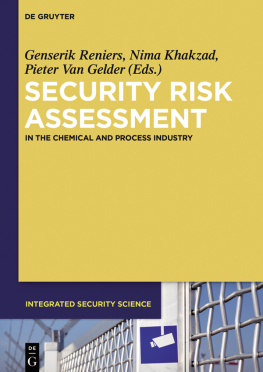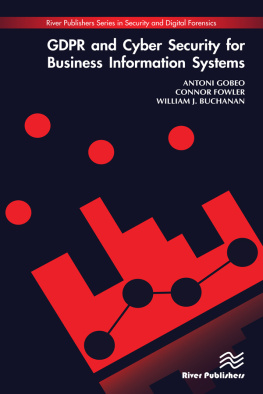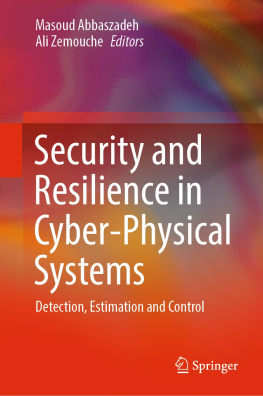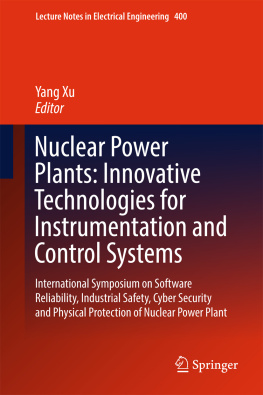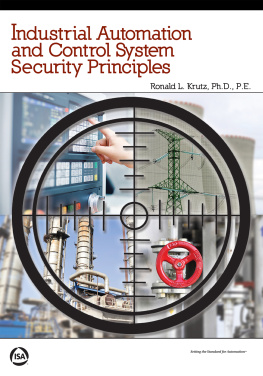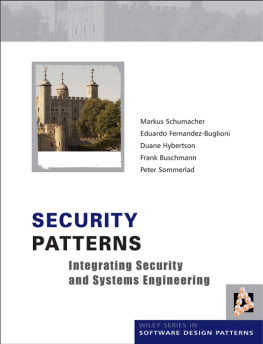Contents
Guide

Reniers, Khakzad, Van Gelder (Eds.)
Security Risk Assessment
Integrated Security Science
Integrated Security Science

Edited by
Genserik Reniers, Nima Khakzad, Pieter Van Gelder
Volume 1

Editors
Genserik Reniers
TU Delft
Safety&Security Science Group
Building 31
Jaffalaan 5
2628 BX Delft
The Netherlands
Nima Khakzad
TU Delft
Safety&Security Science Group
Building 31
Jaffalaan 5
2628 BX Delft
The Netherlands
Pieter Van Gelder
TU Delft
Safety&Security Science Group
Building 31
Jaffalaan 5
2628 BX Delft
The Netherlands
ISBN 978-3-11-050052-3
e-ISBN (PDF) 978-3-11-049908-7
e-ISBN (EPUB) 978-3-11-049776-2
Set-ISBN 978-3-11-049909-4
ISSN 2367-0223
Library of Congress Cataloging-in-Publication Data
A CIP catalog record for this book has been applied for at the Library of Congress.
Bibliographic information published by the Deutsche Nationalbibliothek
The Deutsche Nationalbibliothek lists this publication in the Deutsche Nationalbibliografie;
detailed bibliographic data are available on the Internet at
http://dnb.dnb.de.
2018 Walter de Gruyter GmbH, Berlin/Boston
Cover image: ollo/E+/gettyimages
www.degruyter.com
Preface
Responsible organizations in the chemical industry understand that they are facing a wide variety of threats that may cause harm from intentional acts against them due to the nature and importance of the chemicals they manufacture, distribute, use, and store. While the industry has a long history of managing accidental risks, the efforts toward a similar level of security risk management has been more limited and is just now being more appreciated and understood.
There is an urgency in dealing with security in the chemical industry given the potential for such events and the possible harm that the chemicals may cause. Paramount to proper risk management is the recognition of and evaluation of security risks to identify consequences, vulnerabilities, and threats in an organized, systematic, and repeatable fashion. This information is invaluable to inform management of means to reduce these risks to acceptable levels.
Security risk assessment (SRA) is the foundation of the security risk management (SRM) system since one cannot make optimal decisions when uninformed of security risks. To be effective, SRM is a formal management system on a par with safety, environmental, quality, and other business objectives, and the organization integrates security risk considerations into an enterprise risk management system. It is required to treat the analysis of security in a dynamic process since the threats may rapidly change.
The terrorist acts of 2001 on the United States and many global events since then have created a wave of concern for chemical security since it is a potential means to create large-scale asymmetrical attacks. At the time the industry did not have commonly accepted or standardized best practices for conducting SRAs. It was recognized by governments and professional societies in the industry that development and adoption of SRA methods was required, and considerable guidance has been developed provide information about the best practices.
SRAs done effectively blend with accidental risk assessments to find optimal solutions to achieve higher levels of performance in chemical safety and security. Organizations that embrace SRA and SRM as instrumental practices in their firms will benefit greatly from better decision making on design and operation of facilities and their businesses. It is possible to improve security with intelligent analysis and a holistic consideration of risk in nontraditional ways, such as through inherent security, isolation, defense in depth, and operational risk management rather than only through added layers of security.
With the prevalence of chemicals, the global development of the chemical industry including facilities and the value chain, and the escalating global tensions, the world is once again seeing abuse of standard industrial chemicals for nefarious purposes. These events are stark reminders that require governments and private companies responsible for manufacturing and handling chemicals to find ways to reduce risks while maintaining a vibrant industrial base.
David A. Moore, PE, CSP
President & CEO AcuTech Group, Inc.
www.acutech-consulting.com
List of Contributors
Francesca Argenti
Universit di Bologna
LISES - Dipartimento di Ingegneria Civile,
Chimica, Ambientale e dei Materiali
Via Terracini n. 28
40131 Bologna
Italy
Shailendra Bajpai
National Institute of Technology
Department of Chemical Engineering
Jalandhar
India
Paul Baybutt
Primatech Inc.
50 Northwoods Blvd.
Columbus, OH 43235
USA
Valerio Cozzani
Universit di Bologna
LISES - Dipartimento di Ingegneria Civile,
Chimica, Ambientale e dei Materiali
Via Terracini n. 28
40131 Bologna
Italy
Pieter Van Gelder
Delft University of Technology
Safety and Security Science Group
Jaffalaan 5
2628 BX Delft
The Netherlands
J.P. Gupta
Shiv Nadar University
Dadri (UP)
India
Cecilia Haskins
NTNU - Norwegian University of Science
and Technology
Department of Mechanical
and Industrial Engineering
Trondheim
Norway
Nima Khakzad
Delft University of Technology
Safety and Security Science Group
Jaffalaan 5
2628 BX Delft
The Netherlands
Gabriele Landucci
Dipartimento di Ingegneria Civile e Industriale,
Universit di Pisa, Largo Lucio Lazzarino n. 2,
56126 Pisa
Italy
Nicola Paltrinieri
NTNU - Norwegian University of Science
and Technology
Department of Mechanical
and Industrial Engineering
Trondheim
Norway
Hans J. Pasman
Texas A&M University
Mary Kay OConnor Process Safety Center
(MKOPSC)
College Station, TX 77843
USA
Genserik Reniers
University of Antwerp
Engineering Management
Faculty of Applied Economic Science
Prinsstraat 13
2000 Antwerp
Belgium
Luca Talarico
University of Antwerp
Engineering Management
Faculty of Applied Economic Science
Prinsstraat 13
2000 Antwerp
Belgium
Laobing Zhang
Delft University of Technology
Safety and Security Science Group
Jaffalaan 5
2628 BX Delft
The Netherlands
1Introduction
Safety and security both concern the avoidance and mitigation of losses of different origins (safety looks at possibly unintentionally caused losses, while security is about tackling deliberately caused losses). Our society today is ever more focused on security. However, in the past decades, mainly safety issues were tackled and predominantly safety research was carried out to obtain continuous improvement and higher health and safety figures in organizations of any kind. Questions such as what is safety?, what is risk?, how to manage safety adequately?, who is responsible for safety? , how safe is safe enough?, and other complex topics arose and were investigated by practitioners around the world. They were also studied by researchers from insurance companies as well as by academics and research institutes. Moreover, politicians and regulators came into the discussion with ever more interest in the safety subject. This conglomerate of stakeholders has led to the huge progress that has been made with respect to safety in the past century.

